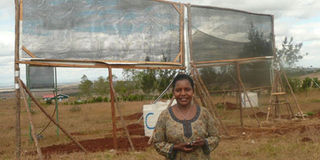You can now harvest water from fog

Prof Bancy Mati, the director of the Water Research and Resource Centre at Jomo Kenyatta University of Agriculture and Technology, stands next to her design of the fog collector in the Ngong Hills, Kajiado County. PHOTO / BONIFACE MWANGI / NATION
What you need to know:
- Atmospheric water vapour normally condenses on cold surfaces into water droplets
- Prof Bancy Mati is working with farmers on how they can harvest fog and turn it into water, a technology that is being used in several nations
Farmers in regions that have dense fog can now harvest water from it for domestic and farm use.
This follows the localisation by a university professor of a technology that enables them harvest water from fog.
Prof Bancy Mati, the director of the Water Research and Resource Centre at Jomo Kenyatta University of Agriculture and Technology, decided to try the idea after she saw difficulties farmers and residents of arid and semi-arid regions go through as they try to get clean water for drinking as well as for growing crops.
“I read how such a project was really doing well in Germany. I thought it was a noble idea that would help many here by increasing water availability particularly in dry, yet foggy months,” says Prof Mati.
Several studies have classified Kenya as water scarce, with dwindling renewable water supply.
ALTERNATIVE SOURCE
Fog comprises a large density of water droplets, which are small enough to "float" in the air.
These tiny droplets, according to Prof Mati, are easily blown by wind, making fog harvesting possible. Fog, Prof Mati notes, has the potential to provide an alternative source of freshwater when harvested through the technology known as fog collectors.
Atmospheric water vapour normally condenses on cold surfaces into water droplets.
The droplets are trapped by special nets erected as fog collectors. Once it condenses, the water is directed into tanks or water containers. A standard fog-harvesting equipment of 40 square metres has the potential of generating 12,000 litres of water daily under adequate atmospheric fog.
Prof Mati’s project is the first in Kenya. However, the technology is not new.
WATER SHORTAGE
In Germany, farmers use water harvested from fog to irrigate their crops using drip or overhead methods.
The fog-collection project is being tested in Kiserian and Corner Baridi, Ngong.
The sites were chosen by Prof Mati because the Ngong Hills have some fog, which, however, may not be as dense as the one in Limuru. Areas near Ngong Hills normally have acute water shortage.
“I went to Ngong Hills because I wanted to test the equipment under less-than-ideal conditions. That way, we have confidence that the results can be replicated with success,” notes Prof Mati, who has installed the fog collectors at Olteyani and Ilmasin primary schools, Olteyani village, Kibiko and Kiserian areas.
“Our results have proved the kits work. They not only harvest fog, but harvest rainwater very well, sometimes better than the roof rainwater system. We started with four research sites, but currently have six test sites.”
COSTLY PROJECT
Prof Mati says she would like to spread the project to other parts of the country, especially in Marsabit, where fog density is high and there is frequent water shortage.
“The project could turn around lives of thousands of Kenyans living in fog-prevalent areas, including Ngong Hills, Aberdares, coastal region and various mountainous areas.”
If one is able to collect plenty of water from fog and store it, says Prof Mati, they can use the waters for irrigation.
Prof Mati says the project is costly. Currently, she has used more than Sh200,000 to localise it. It is the main reason she partnered with four other institutions, besides JKUAT.
These are Ped-World, a German-based NGO, which provides them with fog mesh nets that are not available locally, the Kenya Meteorological Department, which offers them weather data, and Pastoralists Organisation for Water and Environmental Research, an NGO based in Kiserian.
***
The small water droplets present in the fog precipitate when they come into contact with objects. Research suggests that fog collectors could supply water for multiple uses in mountainous areas. Fog can also be harvested in coastal areas when it moves inland, driven by the wind.




